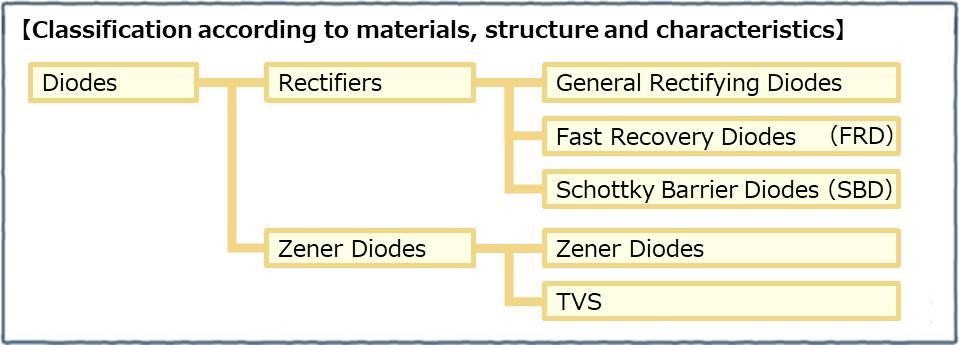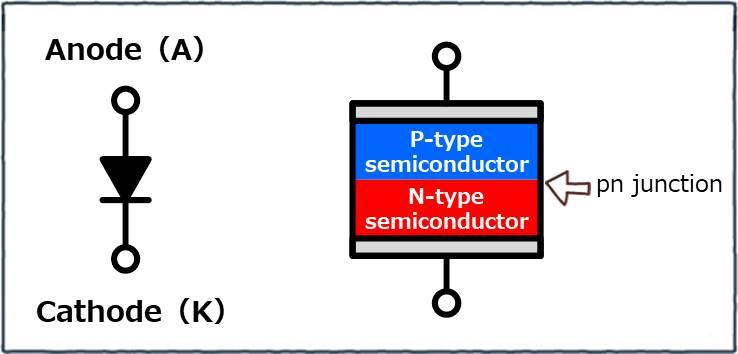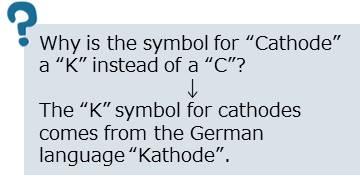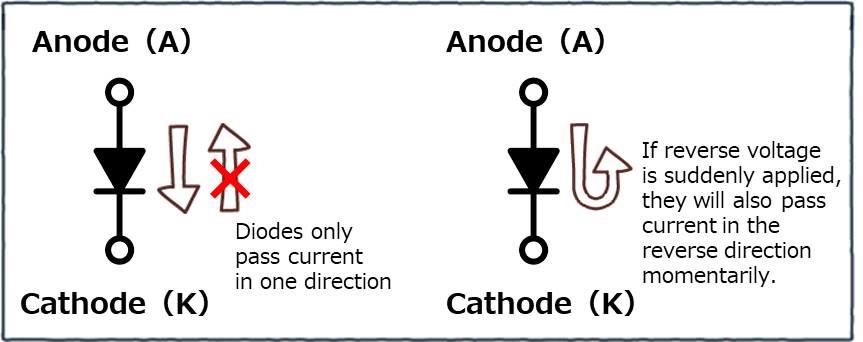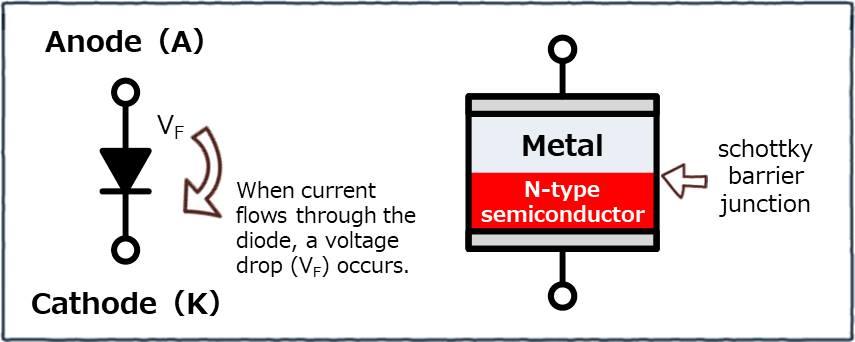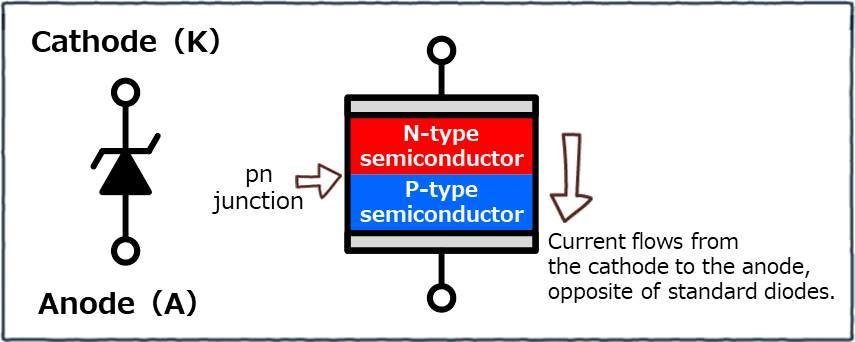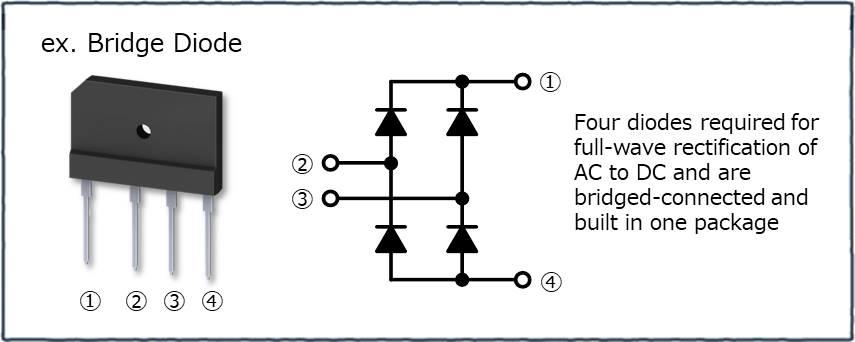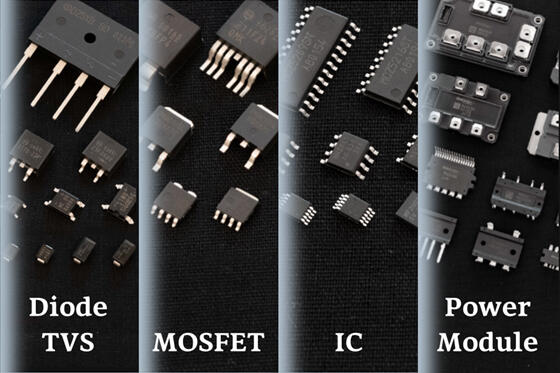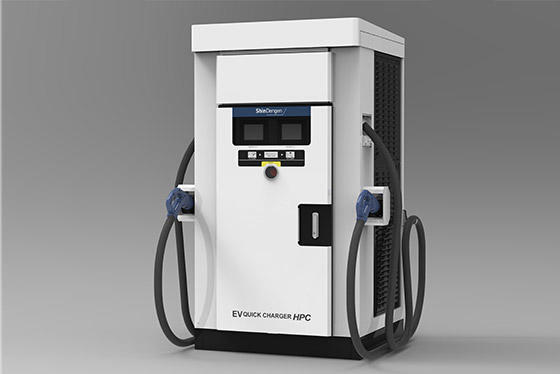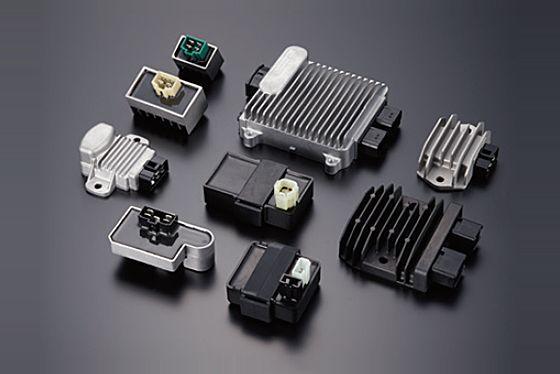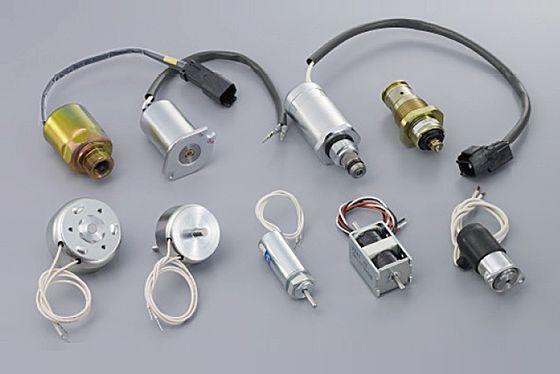Diode classifications
Diodes can be classified according to their materials and characteristics, and can also be classified according to their form and internal wiring, etc.
Diodes can be classified as follows when focusing on materials and characteristics.
Diodes come in a variety of forms depending on usage application, functionality, and other variables, but can be generally classified as Through hole type and Surface mounted type.
In addition, a major classification of diodes classified according to internal wiring characteristics are Bridge diodes.
【Discrete】
A collective name for Transistors, Diodes, Thyristors, and other single function elements which serve as components of semiconductor products.
【Power Module】
A component which forms a power circuit through combination of multiple power semiconductors such as Transistors, Diodes, Thyristors, etc.
Shindengen offers Power Modules which are equipped with either 4 or 6 diodes.
General Rectifying Diodes
Diodes which utilize silicon pn junctions, and which are produced for the purpose of rectifying commercial frequency AC (50/60Hz).
Originally, all silicon diodes were this type, however expansion of usage applications and increased market demand for higher speed and low dissipation led to the development of Fast Recovery Diodes, Schottky Barrier Diodes, etc.
【P-type semiconductor】
This can be simply described as a semiconductor which has positive electrical properties.
【N-type semiconductor】
This can be simply described as a semiconductor which has negative electrical properties.
【pn junction】
Refers to the section where the area of a P-type semiconductor and the area of an N-type semiconductor contact each other.
pn junctions do not “join” a P-type semiconductor and N-type semiconductor together, but rather are formed by creating a P area and N area on a single silicon wafer.
Fast recovery Diodes
This is a pn junction diode (general rectifying diode) which has been sped up.
When a diode is changed from forward bias to reverse bias, current is passed in the reverse direction for a fixed period of time.
This current is called the recovery current, and the period of time this current flows is called the reverse recovery time.
【forward bias】
Refers to applying positive voltage to a diode’s anode side and negative voltage to the cathode side.
Current will flow through the diode.
【reverse bias】
Refers to applying positive voltage to a diode’s cathode side and negative voltage to the anode side.
Current will not flow through the diode.
【recovery current】
Refers to the current which flows through the diode in the reverse direction during reverse recovery time.
【reverse recovery time】
Refers to the time from when the voltage changes to the reverse direction until the current decreases.
It is indicated as “trr”.
The reverse recovery time for general rectifying diodes is from several microseconds to several tens of microseconds. According to the human senses, this is an extremely short period of time, however this time cannot be ignored depending on the circuit being used. For example, if rectifying commercial frequency AC of 50Hz and 60Hz, there is almost no effect, however this time is too long if rectifying switching power supply of 100kHz, and cannot be used because the reverse recovery dissipation would be too high. Fast recovery diodes are diodes which have been sped up to reduce reverse recovery time to only several tens of nanoseconds to several hundred nanoseconds.
【reverse recovery loss】
Refers to dissipation which occurs as a result of recovery current flowing.
This dissipation can be controlled more easily, the shorter the reverse recovery time is.
Schottky Barrier Diodes
This diode uses a metal and N-type semiconductor Schottky barrier junction instead of a pn junction.
When current flows through the diode, a voltage drop called “forward voltage” occurs which causes power dissipation and heat generation. This power dissipation is called the “forward dissipation”.
It is effective to make the forward voltage as small as possible to control the forward dissipation. Schottky Barrier Diodes have a smaller forward voltage than pn junction diodes, so they can be used to significantly reduce forward dissipation.
In addition, they have no reverse recovery time, and are very high speed, so they have superior characteristics, but they also have a shortcoming in that it is difficult to make them high voltage resistant, so they are used as high performance diodes for withstand voltages up to about 200V.
【schottky barrier junction】
This diode uses a Schottky barrier formed by the junction between metal and an N-type semiconductor.
They are named after the German physicist Walter Schottky who discovered their properties.
They are also called MS junctions (metal-semiconductor junctions) when referred to in relation to pn junctions.
【forward voltage】
Refers to the voltage drop which occurs when current flows from the anode to the cathode.
It is indicated as “VF”.
【forward loss】
Refers to the power dissipation which occurs as a result of the IF current which flows in the forward direction and the VF forward voltage.
Forward dissipation=VF×IF [W]
Zener Diodes
These utilize the characteristic of diodes that they do not pass current in the reverse direction and are used to form constant voltage circuits and absorb surge voltage. Those that are used to absorb surge voltage are also sometimes referred to as TVS (Transient Voltage Suppressor) to differentiate them.
Zener diodes are diodes which actively utilize the breakdown-related characteristics of standard diodes.
They flow current from the cathode to the anode, the opposite of standard diodes, to achieve constant voltage, and protect circuits by absorbing energy.
Shindengen’s Zener diodes are silicon TVS which protect circuits from overvoltage from load dump surges, etc., and are distinctive compared to general Zener diodes in that they can withstand higher energy amounts and can respond faster than varistors. General Zener diodes utilize constant voltage characteristics by having a constant small flow of current, but TVS are different in that they do not normally pass current and only operate when necessary.
【breakdown】
Refers to a phenomenon where current exceeding a given voltage rapidly flows when the voltage applied to a diode’s reverse bias is increased.
The voltage during this occurrence is called the “breakdown voltage”.
【load dump】
Refers to a surge (transient high voltage) which occurs as a result of an automobile battery being cutoff.
This surge contains a large amount of energy, so it can damage electronic devices and components.
Bridge Diodes・Power Modules
Bridge diodes are a major classification of diodes classified according to internal wiring characteristics rather than diode characteristics.
Because these are generally used for full wave rectification of commercial power supplies, the majority of the built-in diodes are general rectifying diodes, however there are also products which have Schottky barrier diodes built-in for use in secondary rectification of switching power supplies, etc. There are also products with 6 built-in diodes for use in rectification of 3-phase AC.
In addition to bridge diodes, Shindengen also offers diode modules (power modules), for use in a wide range of applications.
【full‐wave rectification】
Refers to rectification of both the positive and negative waves of alternating current to make the current flow in the same direction.
The rectification of only the positive portion is called half wave rectification.
【three-phase alternating current】
Refers to an electrical transmission method for transmitting large amounts of electricity efficiently. This method allows for achievement of a large amount of power from a small current, so it is used to transmit electricity to devices which require large amounts of power, such as industrial electrical devices, etc.
In comparison, the method used for household use is called “single phase”.
